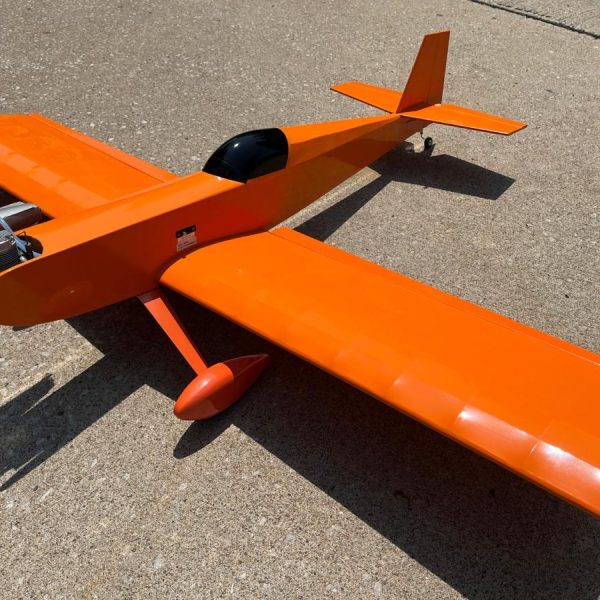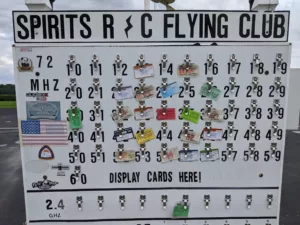Yesterday, May 20, 2023, we had our first Four-Star 40 and “Stock” Electric WARBIRDS races of the year.
It was interesting for me when I heard a comment from Ralph Grant about “putting plutonium” in my fuel!
Made me think…why he would say that, as well as others when I fire up my engines.
The Four-Star 40 I flew was brand new and had one flight on it before yesterday. I bought the airplane at Mark Twain Hobby with an original new O.S. 46 AX engine, not the current AX II version. It was hanging from the ceiling partially built. It had no tail feathers, landing gear, or canopy. The wing and fuselage were built. Whomever started it had already lowered the engine ¼” per our rules, and epoxied the engine area to eliminate fuel getting into any of the joints.
Simply finished it and covered it in orange Monokote. Installed wheel pants…why…I learned when taking flying lessons in a Cessna 172 that the cruise speed increases about 5 MPH with wheel pants on. So, it must work on a model too.
First thing I do is determine the type of engine it is…Ringed, or ABC/ABN non-ringed. That determines the fuel I will use. Run Omega 15% in ringed engines and Cool Power 15% in ABC/ABN engines. ABC/ABN engines are quicker to break-in compared to a ringed engine. We sometimes broke-in a Nelson 40 Quickee ABC engine in less than a minute. As stated above the engine had only one flight on it. Never touched the needle valve setting…left it the same setting from the first flight.
After the race I called Steve Pokorny, and his friend, over to show them what I do with all my nitro engines after each flying day. I emptied the tank and then put the glow plug igniter on and started the engine. It ran for about 15 seconds. Then, tried to start it again and again, to make sure all the residual fuel was not in the engine. Remember, fuel is hygroscopic…which means it draws moisture. Then I closed the carburetor inlet to about 1/32” opening. Filled the inlet up with ATF (Automatic Transmission Fluid) and turned the engine over by hand which draws the ATF into the engine. Did it two more times and flipped the prop to distribute the ATF throughout the engine. I also call this winterizing.
Now for the answer to “How come he’s so FAST”? When I first start my engine I let it idle and start feeling the muffler heating up. As it gets hotter I increase the throttle to about a third, still feeling the muffler getting hotter. When I can’t touch it I open up to about three quarter throttle and listen to it burn off the residual ATF. Then, I go to full throttle and the engine screams. Could it be that ATF not only preserves the engine between usages, but gets into the metal? ATF is slicker than owl manure! Also, the RPM is really high at first and as the ATF is removed it settles down to its normal RPM range.
Understand the reason I feel the temperature of the muffler is that it is a tuned muffler and a tuned muffler only works best when it is hot. This knowledge comes from years of experience with tuned mufflers, and all kinds of tuned pipes, and racing engines. After the muffler is hot…this is also the only time when you would even think about needling the engine, if required. Adjusting the needle before the engine and muffler are warmed up causes you to “chase” a needle setting!
My propellers are always balanced and the leading edge is rounded a little with a straight razor blade to get rid of any “flashing”. Remember the propeller is an air foil, just like a wing. A sharp leading edge kills the “lift” at the stagnation point. (Stagnation point is the point in the leading edge where the air has to decide to go under or over the leading edge). I remove any painted logos on my props too…it also disturbs the airflow of the prop. Any nicks in the propeller are also a no-no. I see so many individuals using props that are obviously not balanced and maybe even have asphalt nicks on the tips. An engine performs best when the propeller is balanced and flashing is removed. One day I gave Greg Tesson one of my balanced props, and his RPM went up almost 1,000 RPM…ask him.
Here’s the simple truth. I take very good care of my equipment, and look at all the details to fly as comfortably as I can by getting the airplane trimmed to the point that is almost flies itself, flying downhill as much as possible to unload the wing, using “snap turns” on the upwind side and a more sweeping turn on the downwind turns. Put it all together…and you pick up more speed.
Paying attention to every detail, just like the Formula 1 race car teams do, is why they are so closely matched. The first ten cars that qualify are usually only thousands of a second apart.
I pay attention to every detail!




